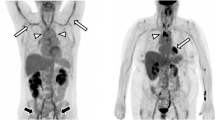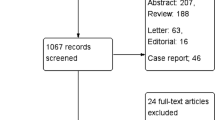Abstract
Purpose
The aim of this study was to analyse if the result of a baseline 18F-fluorodeoxyglucose (FDG) positron emission tomography (PET)/CT scan, in large-vessel vasculitis (LVV) patients, is able to predict the course of the disease, not only in terms of presence/absence of final complications but also in terms of favourable/complicated progress (response to steroid therapy, time to steroid suspension, relapses, etc.).
Methods
A total of 46 consecutive patients, who underwent 18F-FDG PET/CT between May 2010 and March 2013 for fever of unknown origin (FUO) or suspected vasculitis (before starting corticosteroid therapy), were enrolled. The diagnosis of LVV was confirmed in 17 patients. Considering follow-up results, positive LVV patients were divided into two groups, one characterized by favourable (nine) and the other by complicated progress (eight), on the basis of presence/absence of vascular complications, presence/absence of at least another positive PET/CT during follow-up and impossibility to comply with the tapering schedule of the steroid due to biochemical/symptomatic relapse. Vessel uptake in subjects of the two groups was compared in terms of intensity and extension. To evaluate the extent of active disease, we introduced two volume-based parameters: “volume of increased uptake” (VIU) and “total lesion glycolysis” (TLG). The threshold used to calculate VIU on vessel walls was obtained by the “vessel to liver” ratio by means of receiver-operating characteristic analysis and was set at 0.92 × liver maximum standardized uptake value in each patient.
Results
Measures of tracer uptake intensity were significantly higher in patients with complicated progress compared to those with a favourable one (p < 0.05). Measures of disease extension were even more significant and TLG emerged as the best parameter to separate the two groups of patients (p = 0.01).
Conclusion
This pilot study shows that, in LVV patients, the combined evaluation of the intensity and the extension of FDG vessel uptake at diagnosis can predict the clinical course of the disease, separating patients with favourable or complicated progress.





Similar content being viewed by others
References
Jennette JC, Falk RJ, Andrassy K, et al. Nomenclature of systemic vasculitides. Proposal of an international consensus conference. Arthritis Rheum 1994;37(2):187–92.
Jennette JC, Falk RJ, Bacon PA, et al. 2012 revised International Chapel Hill Consensus Conference Nomenclature of Vasculitides. Arthritis Rheum 2013;65(1):1–11.
Balink H, Bennink RJ, van Eck-Smit BLF, et al. The role of 18F-FDG PET/CT in large-vessel vasculitis: appropriateness of current classification criteria? Biomed Res Int 2014;2014:687608.
Muratore F, Kermani TA, Crowson CS, et al. Large-vessel giant cell arteritis: a cohort study. Rheumatology (Oxford) 2015;54(3):463–70.
Germanò G, Muratore F, Cimino L, et al. Is colour duplex sonography-guided temporal artery biopsy useful in the diagnosis of giant cell arteritis? A randomized study. Rheumatology (Oxford) 2015;54(3):400–4.
Salvarani C, Cantini F, Hunder GG. Polymyalgia rheumatica and giant-cell arteritis. Lancet 2008;372(9634):234–45.
Katsuyama T, Sada KE, Makino H. Current concept and epidemiology of systemic vasculitides. Allergol Int 2014;63:505–13.
Prieto-González S, Arguis P, Cid MC. Imaging in systemic vasculitis. Curr Opin Rheumatol 2015;27(1):53–62.
Belhocine T, Blockmans D, Hustinx R, et al. Imaging of large vessel vasculitis with 18F-FDG PET: illusion or reality? A critical review of the literature data. Eur J Nucl Med Mol Imaging 2003;30:1305–13.
Glaudemans AWJM, de Vries EFJ, Galli F, et al. The use of (18)F-FDG-PET/CT for diagnosis and treatment monitoring of inflammatory and infectious diseases. Clin Dev Immunol 2013;2013:623036.
Santhosh S, Mittal BR, Gayana S, et al. 18F-FDG PET/CT in the evaluation of Takayasu arteritis: an experience from the tropics. J Nucl Cardiol 2014;21:993–1000.
Prieto-Gonzáles S, Depetris M, Garcia-Martinez A, et al. Positron emission tomography assessment of large vessel inflammation in patients with newly diagnosed, biopsy-proven giant cell arteritis: a prospective, case–control study. Ann Rheum Dis 2014;73(7):1388–92.
Osborn EA, Jaffer FA. The advancing clinical impact of molecular imaging in CVD. JACC Cardiovasc Imaging 2013;6(12):1327–41.
Papathanasiou ND, Du Y, Menezes LJ, et al. 18F-Fludeoxyglucose PET/CT in the evaluation of large-vessel vasculitis: diagnostic performance and correlation with clinical and laboratory parameters. Br J Radiol 2012;85(1014):e188–94.
Sanchez-Roa P, Rees J, Nash J, et al. FDG PET in the early diagnosis of large-vessel vasculitis. Eur J Nucl Med Mol Imaging 2013;40:974–5.
Tezuka D, Haraguchi G, Ishihara T, et al. Role of FDG PET-CT in Takayasu arteritis: sensitive detection of recurrences. JACC Cardiovasc Imaging 2012;5(4):422–9.
Zerizer I, Tan K, Khan S, et al. Role of FDG-PET and PET/CT in the diagnosis and management of vasculitis. Eur J Radiol 2010;73(3):504–9.
Muto G, Yamashita H, Takahashi Y, et al. Large vessel vasculitis in elderly patients: early diagnosis and steroid-response evaluation with FDG-PET/CT and contrast-enhanced CT. Rheumatol Int 2014;34(11):1545–54.
Rozzanigo U, Pellegrin A, Centonze M, et al. Diagnosis of large-vessel vasculitis using [18F]-FDG PET-CT. Radiol Med 2013;118:633–47.
Jamar F, Buscombe J, Chiti A, et al. EANM/SNMMI guideline for 18F-FDG use in inflammation and infection. J Nucl Med 2013;54(4):647–58.
Hautzel H, Sander O, Heinzel A, et al. Assessment of large-vessel involvement in giant cell arteritis with 18F-FDG PET: introducing an ROC-analysis–based cutoff ratio. J Nucl Med 2008;49:1107–13.
Martínez-Rodríguez I, Del Castillo-Matos R, Quirce R, et al. Aortic 18F-FDG PET/CT uptake pattern at 60 min (early) and 180 min (delayed) acquisition in a control population: a visual and semiquantitative comparative analysis. Nucl Med Commun 2013;34(9):926–30.
Martínez-Rodríguez I, Martínez-Amador N, Banzo I, et al. Assessment of aortitis by semiquantitative analysis of 180-min 18F-FDG PET/CT acquisition images. Eur J Nucl Med Mol Imaging 2014;41(12):2319–24.
Besson FL, de Boysson H, Parienti JJ, et al. Towards an optimal semiquantitative approach in giant cell arteritis: an (18)F-FDG PET/CT case–control study. Eur J Nucl Med Mol Imaging 2014;41:155–66.
Puppo C, Massello M, Paparo F, et al. Giant cell arteritis: a systematic review of the qualitative and semiquantitative methods to assess vasculitis with 18F-fluorodeoxyglucose positron emission tomography. Biomed Res Int 2014;2014:574248.
Blockmans D, de Ceuninck L, Vanderschueren S, et al. Repetitive 18F-fluorodeoxyglucose positron emission tomography in giant cell arteritis: a prospective study of 35 patients. Arthritis Rheum 2006;55(1):131–7.
Figueroa AL, Abdelbaky A, Truong QA, et al. Measurement of arterial activity on routine FDG PET/CT images improves prediction of risk of future CV events. JACC Cardiovasc Imaging 2013;6(12):1250–9.
Blockmans D, Bley T, Schmidt W. Imaging of large-vessel vasculitis. Curr Opin Rheumatol 2009;21:19–28.
Biggi A, Burroni L, Carena M, et al. Raccomandazioni procedurali per lo studio delle infezioni-infiammazioni. AIMN, 2011. Available via http://www.aimn.it/pubblicazioni/LG/RP_AIMN_infezioni.pdf.
Meller J, Strutz F, Siefker U, et al. Early diagnosis and follow-up of aortitis with [(18)F]-FDG PET and MRI. Eur J Nucl Med Mol Imaging 2003;30(5):730–6.
Weyand CM, Goronzy JJ. Clinical practice. Giant-cell arteritis and polymyalgia rheumatica. N Engl J Med 2014;371(1):50–7.
Maffioli L, Mazzone A. Giant-cell arteritis and polymyalgia rheumatica. N Engl J Med 2014;371(17):1652–3.
Mukhtyar C, Guillevin L, Cid MC, et al. EULAR recommendations for the management of large vessel vasculitis. Ann Rheum Dis 2009;68:318–23.
Larson SM, Erdi Y, Akhurst T, et al. Tumor treatment response based on visual and quantitative changes in global tumor glycolysis using PET-FDG imaging. The visual response score and the change in total lesion glycolysis. Clin Positron Imaging 1999;2(3):159–71.
Blockmans D, Maes A, Stroobants S, et al. New arguments for a vasculitic nature of polymyalgia rheumatica using positron emission tomography. Rheumatology (Oxford) 1999;38(5):444–7.
Hara M, Goodman PC, Leder RA. FDG-PET finding in early-phase Takayasu arteritis. J Comput Assist Tomogr 1999;23(1):16–8.
Hunder GG, Arend WP, Bloch DA, et al. The American College of Rheumatology 1990 criteria for the classification of vasculitis. Introduction. Arthritis Rheum 1990;33(8):1065–7.
Hunder GG, Bloch DA, Michel BA, et al. The American College of Rheumatology 1990 criteria for the classification of giant cell arteritis. Arthritis Rheum 1990;33(8):1122–8.
Arend WP, Michel BA, Bloch DA, et al. The American College of Rheumatology 1990 criteria for the classification of Takayasu arteritis. Arthritis Rheum. 1990;33(8):1129–34.
Blockmans D, Coudyzer W, Vanderschueren S, et al. Relationship between fluorodeoxyglucose uptake in the large vessels and late aortic diameter in giant cell arteritis. Rheumatology (Oxford) 2008;47(8):1179–84.
Bai B, Bading J, Conti PS. Tumor quantification in clinical positron emission tomography. Theranostics 2013;3(10):787–801.
Kim TM, Paeng JC, Chun IK, et al. Total lesion glycolysis in positron emission tomography is a better predictor of outcome than the International Prognostic Index for patients with diffuse large B cell lymphoma. Cancer 2013;119(6):1195–202.
Moon SH, Hyun SH, Choi JY. Prognostic significance of volume-based PET parameters in cancer patients. Korean J Radiol 2013;14(1):1–12.
Compliance with ethical standards
Conflicts of interest
None.
Statement of human rights
For this type of study formal consent is not required.
Statement on the welfare of animals
This article does not contain any studies with animals performed by any of the authors.
Informed consent
Informed consent for PET/CT scans was obtained from all individual participants included in the study. No additional informed consent was needed.
Author information
Authors and Affiliations
Corresponding author
Rights and permissions
About this article
Cite this article
Dellavedova, L., Carletto, M., Faggioli, P. et al. The prognostic value of baseline 18F-FDG PET/CT in steroid-naïve large-vessel vasculitis: introduction of volume-based parameters. Eur J Nucl Med Mol Imaging 43, 340–348 (2016). https://doi.org/10.1007/s00259-015-3148-9
Received:
Accepted:
Published:
Issue Date:
DOI: https://doi.org/10.1007/s00259-015-3148-9




